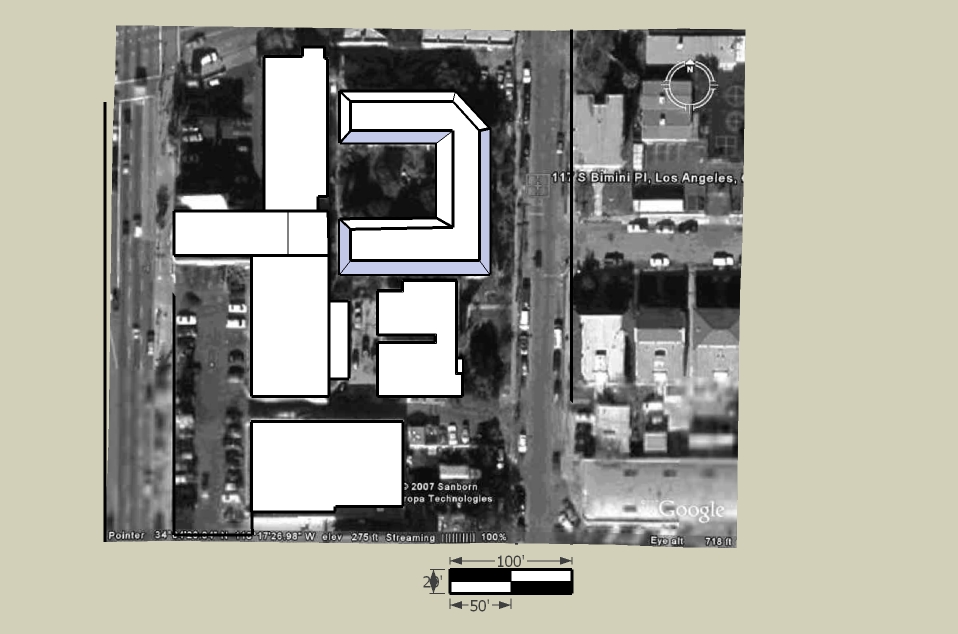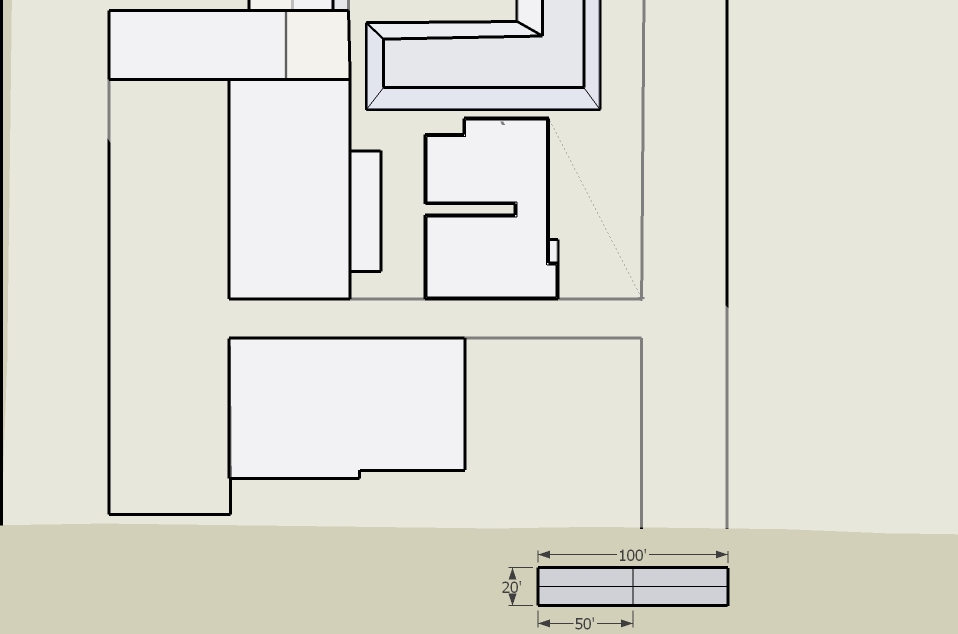This is some of the information related to one of the groups formed during the 2007 Urban Permaculture Design Course. Members where Lara, Yuki and Federico. Some information here might be useful for future reference.
Our focus area was the alley next to the Philipino supermarket and the area of the garages.
Plant Information
Alley
- Keep the existing prickly pear cactus, sage bush and yarrow, which are doing well without being watered.
- Take advantage of the full sun of the southeast portion of the alley to add two edible trees, carob and pecan.
- Place several olive trees in proximity to our single olive to aid pollination and produce edible oil.
- Plant two more macadamia nut trees for additional nuts and to provide shade. The existing macadamia on the adjacent corner is producing well with minimal care.
- Landscape around the trees and path with drought tolerant plants that can take full sun and traffic.
- Garden
- We are currently growing avocado, fig, sapote, guava, chermoya, persimmon, tangelo, and tangerine trees in this area.
- The plan expands the fruit production to year-round by using gray water and planting dwarf and semi-dwarf orange, lemon, kumquat, apple varietals and lime trees near the south and east-facing walls. Blueberries, currants and thorn-less blackberries can grow between the new trees on the south wall of the Bimini Terrace.
- Trellises will be used to extend the growing area for vines to the second floor of each building.
- Plants will be placed so size decreases from east to west and from north to south to optimize access to the sun. The plant list is sorted by height to reflect this gradation.
- Seedlings grown in the greenhouse will replace the annual plants as they finish producing to maximize pounds of produce harvested.
- Focus area
- Keep the existing palm and pomegranate tree, which provide greenery and pomegranates.
- Create a green wall using vines (passion fruit, kiwi, cherry tomatoes and nasturtiums) and attached baskets (strawberries, nasturtiums, pansies, violas and mixed greens) – food, beauty and cooling.
- Bamboo is used to screen the sitting area, provide edible shoots and building material.
- Place papayas, which can be squeezed into a small space, near the fountain to shade the seating, produce fruit and enhance the ambiance.
Suitable Plants for this area
Blueberries - Sunshine Blue
Southern Highbush. Evergreen, compact habit to 3 ft. Showy pink bloom. Heavy crops. Very low chilling requirement (150 hours) yet frost hardy. Tolerates higher pH soils better than other varieties.
Blueberries - Misty
Southern Highbush. Early. In the west, Misty is quite vigorous, growing very well both on the coast and in the inland heat. This excellent fruit does well in areas with chilling as low as 150 hours and all areas with mild winters and hot summers.
Figs - Black Mission, Janice Seedless, Kadota and Panache. These three Figs planted together will give you a purple, a variegated and a yellow-green fruit with a prolonged harvest from July to first frost.
Grapefruit. Oro Blanco Hybrid, November through March –
Grapefruit. Chandler Pummelo, January through May –
Grapefruit. Rio Red Ruby April through September
Lemon. Meyer Lemon, ever bearing –
Lemon. Eureka Lemon, ever bearing -
Lemon. Pomona Sweet Lemon, fall through spring -
Lime. Thornless Mexican Lime, fall winter –
Lime. Bearss Seedless Lime, fall through winter
Lime. Palestine Sweet Lime, fall through spring
Kaffir Lime - fruits from November through March, Foliage year round –
Limequat, ever bearing –
Kumquat, ever bearing Mandarin. Satsuma, November to March –
Mandarin. Honey, February to May –
Mandarin. Gold Nugget, April through summer
Orange. Cara Cara, December to May –
Orange. Moro Blood, February to May -
Orange. Midnight Valencia, April through summer
Persimmons - Fuyu, Hachiya, Chocolate and Coffee Cake (Nishimura Wase)
September through December
Garden Prince Genetic Dwarf Almond Compact, lushly foliated 10-12ft. tree. Soft shell, kernels especially sweet and tasty. Bears young and heavy. Large, light pink blossoms. 250 hours. Self-fruitful. Pat. No. 5146. (Zaiger)
Western Schley Pecan Easy to grow, hardy tree. Less fussy about soil and nutrition than other pecan varieties. Long, tapered, medium-sized, thin-shelled nuts. Fine quality, mid-season. 250 hours. Self-fruitful.
Apple - Beverly Hills
Long-time favorite summer apple for coastal So. California. Pale yellow, red blush or stripes. Medium size, slightly tart. Fresh/cooked. 300 hours. Self-fruitful.
Apple - Einshemer
Heavy-bearing, very low chilling requirement. Sweet yellow apples in early summer (late June in Central Calif). Excellent pollenizer for Anna. 100 hours. Self fruitful.
Apple - Gordon
Popular variety for Southern Calif. Low chilling requirement, about 400 hours. Red over green skin, good quality. For fresh use and cooking. Self fruitful. Pat. No. 4144.
Apple - Pink Lady (Cripps Pink)
New hot climate apple from Western Australia. Very crisp, sweet-tart, distinct flavor, good keeper. Skin reddish-pink over green when ripe. White flesh resists browning. Harvest begins late October in Central CA, about three weeks after Fuji. Self-fruitful. 4-500 hours. Pat.No. 7880.
Apple - Red Fuji
Redder-skinned bud sport of Fuji. Sweet, very crisp and flavorful, excellent keeper. Ripe September-October in Central Calif. Excellent pollenizer for other apple varieties. Self-fruitful.
Apple - White Winter Pearmain
High quality, all-purpose apple - an old favorite, especially for fresh use. Widely adapted, including California’s mild-winter coastal climates. Medium to large size, round to oval shape, pale yellow skin with dull red blush. Cream-colored flesh is fine-grained, crisp, juicy and aromatic with a rich, subacid to sprightly flavor. September/October harvest, good keeper. Healthy, vigorous, spreading, heavy-bearing tree. Excellent pollinator for other apples. Believed to be the oldest known English apple, dating back to 1200 A.D. Low winter chilling requirement, about 400 hours. Self fruitful.
Apple - Winter Banana
Large, round, especially beautiful apple - pale yellow waxy skin blushed with rosy pink. Crisp, tangy, juicy flesh is highly aromatic with a mild, banana-like flavor. Long-time favorite dessert apple in California’s mild-winter coastal climates. Good cider apple. Harvest mid to late-September in Central California. Good keeper. Vigorous, spreading tree bears at young age. Excellent pollinator for other apples. Originated in Indiana, introduced in 1890. Low winter chilling requirement, less than 400 hours. Partly self fruitful, biggest crops if cross-pollinated.
Olive - Amphissis
Also known as: AMFISA, AMFISSA, KONSERVOLIA, MILOLIA, PATRINI, PILIOU SALONIKIKI
Area of origin: GREECE
TREE: A tree of strong vigor with a spreading habit and canopy of medium density. The leaves are broad and flat of medium length giving an elliptic lanceolate shape.
FRUIT: A dual purpose olive of high weight; ovoid and asymmetric in shape. The timing of harvest depends on the use of the fruit which may be for green or black olives or for oil. Oil content is medium.
AGRONOMY: Amphissis grows quickly and comes into bearing in 3 or 4 years. Productivity is high but alternate. The pistil abortion rate is high. Resistance to cold and olive knot is good, but it is sensitive to vemticillium wilt and overly dry conditions.
COMMENTS: This tree adapts to many environmental conditions, it can be grown up tp 2000 feet above sea level. This fact combined with the versitility of the fruit (green or black olives or oil) accounts for it being planted on over 70 % of Greece’s table growing acreage.
Avocado - Hass Origin Rudolph Hass, La Habra Heights, 1926. Seedling of Lyon. Guatemalan. Tree rather open, not tall. Fruit medium, to 12 oz., pyriform, skin thick, pebbled, coppery purple. Flesh good, oil 19%, seed fairly small. Currently the standard of the industry. To 26° F. Season July.
Carob (Ceratonia siliqua L.) Tree; Culinary, Medicinal (St. John’s Bread) is a slow-growing evergreen tree with rich, glossy foliage. Carob is native to the Eastern Mediterranean area. The tree blooms in the autumn and carries the young fruit to the end of the next summer. Its fruits/pods are rich in protein and sugar and are used in chocolate and pastry manufacturing and for photographic emulsion. Carob pods are also used as nutritious animal feed, whereas the herbaceous ground cover makes good pasture [Moussouris and Regato, 1999; Russel and Smith, 1950]. Ceratonia siliqua L. bears fruit at the age of six to eight years. At an average, a tree then yields 200-250 lb/a of fruit. The abundance of fruit is greater every second year. Also the seeds are edible and produce a protein-rich flour that contains no starch or sugar and is ideal for diabetics. The endosperm is extracted from the seed to produce galactomannan, which forms locust bean gum, a food additive. The pod is used for high-energy livestock feed and in the production of cocoa products and syrups. These are used as a substitute for cocoa and as a food (also known as algarroba, St. John’s bread, and locust bean gum) [Goor and Barney].
Carob is a typical Mediterranean tree species that can be found in the coastal areas. In Lebanon for example it can be found up to 800 m, where it represents an important source of additional revenue to many local farmers. Both wild and cultivated populations can be found, often close to each other or even mixed. The wild populations can be found under very different environmental conditions, showing different growth characteristics. The fruits from carob are harvested in September. In Portugal and Spain, most carob plantings are located on steep, rock sites, unsuitable for other agricultural crops and require hand harvesting. Harvesting represents 30-35 percent of the total production cost. Harvested carob pods are first “kibbled”, a coarse grinding process that separates the pod from the unbroken seeds.
In large parts of its distribution range, Ceratonia siliqua is under increasing pressure, mainly because of urbanization and conversion of areas to agricultural land. This degradation of carob populations seems to be symptomatic of the decline of the whole natural vegetation of the coastal regions [Breugel and Stephan, 1999].
Carob production is presently centered in Portugal and Spain, which have about 100 000 ha of carob trees and process about half of the world’s commercial supply. World production is presently about 315 000 tonnes per year and the main producers are Spain (42%), Italy (16%), Portugal (10%), Morocco (8%), Greece (6.5%), Cyprus (5.5%) and Turkey (4.8%).
Carob has been introduced to temperate regions in Central America and also to Australia. More information on Carob is also described in the Non Wood Forest Products Series no. 6: Gums, Resins and Latexes of Plant Origin (FAO, 1995).
The seeds of this tree are used as a chocolate or coffee substitute and is rich in sugars and protein. They are also ground into a flour for baking or used for thickening. Seed pulp is used to treat diarrhea and to relieve stomach disorders, and to treat coughs. Bark from the tree is very astringent. The tree is evergreen and is hardy to 20F and is a nitrogen fixer. It requires full sun and a well-drained soil, though not particular about the type.
Prosopis - The genus Prosopis (family Leguminosae) consists of about 45 species of small- to medium-sized trees or shrubs. Most occur in the Western Hemisphere in semi-arid temperate regions, but three species are found in Asia and Africa [Little, 1979]. The seed pods of several species of Prosopis are edible and used as food for human consumption or as a livestock feed.
In the desert regions of Arizona and California, Prosopis pods were an important food for indigenous tribes. Large trees with a 40-60 cm basal diameter, growing in riparian zones in this region, can yield up to 40 kg of pods per tree. The pods contain approximately 13 percent protein and 35 percent sugar. They were ground into flour with stone mortars, and the hard seeds were often discarded. The pods of Argentinian species of Prosopis were used in a similar manner and research is currently under way in Peru to develop industrial processes that will produce products from the pods of these trees that will appeal to contemporary human societies. In the United States, some cottage industries have arisen that make jelly and flour from Prosopis pods. The pods have a strong mocha-cinnamon aroma, and a potential exists for producing special baking flour for muffins and fruitcakes. In India, the green pods of Prosopis cineraria are a popular human food, and in some locations the crop price in the marketplace is US$2.00/kg, more than half the average daily wage [Felker, 1998].
A current limitation to widespread use of Prosopis pods for human food in the United States is the high cost of manual harvest in natural forests. If trees could be grown in straight rows in orchards and pod harvesting could be mechanized, an industry based on production for human use could be developed [Felker, 1998].
In the arid regions of northern Chile (Regions I-III), Prosopis spp., principally P. tamarugo (common name tamarugo) and P. chilensis (common name algarrobo), cover an area of approximately 20 000 ha. The fruits of these trees are an important and nutritious source of fodder for livestock, including cattle, sheep and goats [Garfias Salinas et al., 1995]. In Argentina, the fruits of Prosopis spp. are used as a cattle feed and in the production of a fermented beverage [Résico, 1995].
Chayote, Mirliton Sechium edule is a member of the Cucurbitaceae (gourd) family.
The chayote plant has climbing vines and leaves resembling those of a cucumber. In the tropics the plant is a perennial with stems 50 or more feet long and possessing tendrils. The plant produces separate male and female flowers, and bees are required for pollination. The light green, pear-shaped fruit contains a single, edible seed about one to two inches long. Varieties range from almost smooth to deeply ridged and from cream to apple green in color. It may have non-sticking prickles covering it. The fruit may weigh from eight to ten ounces to more than a pound and is three to eight inches long. It was cultivated centuries ago in Central America by the Aztecs and Mayans.
Comfrey (Symphytum spp.) is native to Europe and Asia. Although comfrey has been used as a food crop, and as a forage crop.
Borage (Borago officinalis or echium amoenum) Attracts beneficial insects, provides beautiful blue edible flowers.



